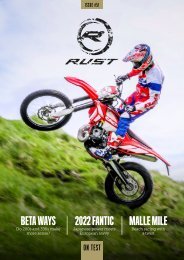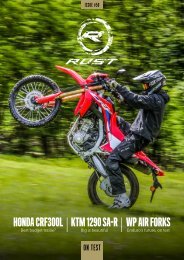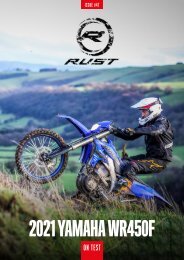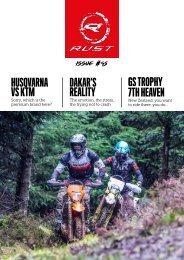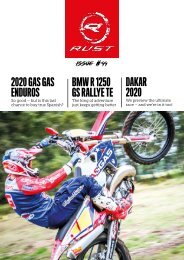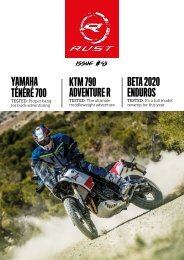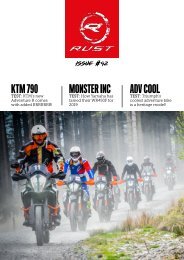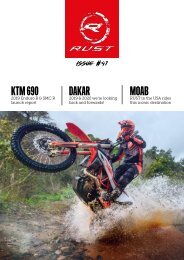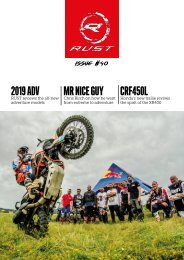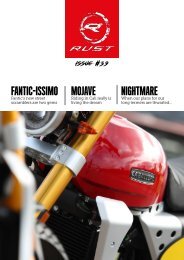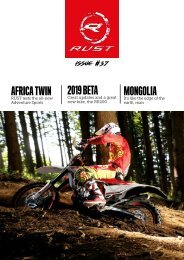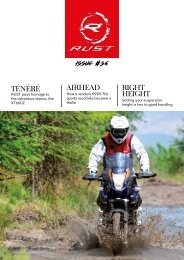RUST magazine: Rust#1
RUST magazine: Hi and congratulations on making one helluva jump… You’ve just sailed straight over the top of the other mags and landed on RUST. RUST is a bold new digital dirt bike project that takes over from TBM, and aims to be more than just a great read. Beginning with an in‐depth, intelligently-written FREE digital magazine, RUST will develop over the coming months into a multi-layered riders’ resource, blending the written word with fast-moving video content and a free-to-access back-issue archive. With a nod to the past and our eyes firmly on the future, RUST will tear down the boundaries between print, digital and social media, bringing them all together under one digital awning. So here for your enjoyment is the first issue of RUST… With all of the great bits of TBM and none of the cost of refuelling, what’s not to like? Key in your email address and we’ll ensure you stay ahead of the pack for all upcoming issues. Feel free to comment on our social media and leave us your feedback. After all RUST is more than just a name… it’s a 'brand of brothers'.
RUST magazine: Hi and congratulations on making one helluva jump… You’ve just sailed straight over the top of the other mags and landed on RUST. RUST is a bold new digital dirt bike project that takes over from TBM, and aims to be more than just a
great read.
Beginning with an in‐depth, intelligently-written FREE digital magazine, RUST will develop over the coming months into a multi-layered riders’ resource, blending the written word with fast-moving video content and a free-to-access back-issue archive. With a nod to the past and our eyes firmly on the future, RUST will tear down the boundaries between print, digital and social media, bringing them all together under one digital awning.
So here for your enjoyment is the first issue of RUST… With all of the great bits of TBM and none of the cost of refuelling, what’s not to like? Key in your email address and we’ll ensure you stay ahead of the pack for all upcoming issues. Feel free to comment on our social media and leave us your feedback. After all RUST is more than just a name… it’s a 'brand of brothers'.
You also want an ePaper? Increase the reach of your titles
YUMPU automatically turns print PDFs into web optimized ePapers that Google loves.
issue #1<br />
www.rustsports.com
Ed itorial<br />
welcome<br />
to rust<br />
<strong>magazine</strong><br />
By SI MELBER, photo: selfie<br />
“Rust NeverSleeps”<br />
-Neil Young-<br />
Hi there<br />
WE’RE <strong>RUST</strong>. A new dirtbike Sports Media Company, and a whole new brand<br />
founded on 20 years of industry experience. <strong>RUST</strong> takes over from the highly<br />
acclaimed TrailBike & Enduro Magazine (TBM), bringing together modern<br />
multimedia content with 20 years worth of resources, case-hardened<br />
knowledge and incredible imagery.<br />
Why <strong>RUST</strong>? Because rust is what happens when we stop riding: metal<br />
corrodes and decays, and our bodies weaken. In short we become ‘rusty’.<br />
<strong>RUST</strong> is all about challenging that notion. <strong>RUST</strong> is an anti-brand.<br />
Moreover <strong>RUST</strong> encompasses our own experiences. <strong>RUST</strong> is the ‘witness<br />
mark’ of a lifetime of dirt and grime. It’s the proof you ride in all seasons,<br />
irrespective of the conditions. And it’s the knowledge we’ve gathered over the<br />
years that reflects our hard-won experiences. Ultimately <strong>RUST</strong> is the piece of<br />
grit in the oyster that makes the pearl…
<strong>RUST</strong> aims to be maverick, opinionated and hard-hitting, but it will also be<br />
honest and fair. <strong>RUST</strong> will blend wit and wisdom: in-depth stories with considered<br />
editorial, expert advice with a real-world angle. <strong>RUST</strong> is about people,<br />
places and points of view as much as the bikes, the kit and the performance.<br />
And shortly every <strong>RUST</strong>afarian like you and me will have a new dropping-off<br />
point. A place to go with your morning coffee, lunchtime sandwich or evening<br />
beer. Where you can sit and read about dirtbikes and simply chill.<br />
In the meantime we want you to get a taste for what <strong>RUST</strong> is all about, so<br />
here’s the first issue of our new digital <strong>magazine</strong> absolutely free. Future issues<br />
will remain free to download from our website. We hope it inspires you to get<br />
out there and ride…<br />
Si Melber<br />
We want to hear from you. Contact editorial@rustsports.com with your feedback.
St aff<br />
Si Melber is the founding editor of TrailBike &<br />
Enduro Magazine, former features editor of<br />
Motorcycle International Magazine and a<br />
winner of the Rookie-of-the-year award in the<br />
24hour Citroen 2CV endurance challenge.<br />
As a kid he built his own sidecar push-bike,<br />
but now rebuilds various dirt bikes, a ’57<br />
Chevy pick-up and his crumbling old house.<br />
His work has appeared on the Advertising<br />
Standard Authority’s ‘Wall of Shame’.<br />
Jon Bentma<br />
<strong>magazine</strong>,<br />
Extreme, M<br />
Kiwi Rider.<br />
New Zealan<br />
and once e<br />
Magazine.<br />
doesn’t act<br />
shelves in h<br />
Rick Kemp cut his teeth as an assistant<br />
photographer (and fluffer) at Vogue Studios.<br />
Riding from the age of 15 he raced enduro on<br />
a Yam IT175, worked on Dirt Bike Rider and<br />
scooped top journo at the inaugural Weston<br />
Beach Race. The former editor of F1 News<br />
and founder member of the Groucho club, he<br />
now lives with two dogs, an old Mercedes<br />
wagon and several motorcycles old and new.<br />
He is currently tuning up his Stannah stairlift.<br />
David Knig<br />
champion (<br />
champion,<br />
Erzberg En<br />
gold-meda<br />
other outdo<br />
He lives on<br />
Daisy and<br />
old trials bi<br />
he likes to<br />
Andy Riley is a cantankerous, hairy old biker,<br />
who has been designing <strong>magazine</strong>s since<br />
’81 (that’s 1881). He has worked on Custom<br />
Car, Hot Rod & Custom, Auto Performance,<br />
Automotive & Commercial Refinisher, Auto<br />
Trade, Heavy Duty, Back Street Heroes,<br />
Which Bike, Breaker, HOG, MotorCycle<br />
International and TBM. And in that time he<br />
has learnt virtually nothing. He still owns a<br />
Harley, though like him it hasn’t run in years.<br />
Warren Ma<br />
South Afric<br />
gym-going,<br />
He hides in<br />
of a private<br />
ously TBM<br />
anarchistic<br />
Guernsey i<br />
wife, son a<br />
favourite w
n is the founding editor of Moto X<br />
and former editor of Enduro<br />
otorcycle Sport & Leisure and<br />
He is a two-time winner of the<br />
d Dusk-till-Dawn Dog Sled Race<br />
dited Good Woodworking<br />
Nevertheless he admits he<br />
ually own a saw and all the<br />
is house in Kent are crooked.<br />
Georgia Wells (aka PitGirl) describes herself<br />
as addicted to Enduro, crazy about animals,<br />
mad for music, daft for dancing, obsessed<br />
with MotoGP and generally awash with<br />
Red Bull. We know her as the most erudite<br />
enduro journalist we’ve ever met. This social<br />
media geek lives in Wiltshire with two<br />
Burmese cats and says her favourite<br />
perfume is the scent of two-stroke oil.<br />
ht is a three-time World Enduro<br />
E3), twice American GNCC<br />
19 times British champion, double<br />
duro winner, multi-time ISDE<br />
l winner and victor of countless<br />
or and indoor extreme enduros.<br />
the Isle of Man with his two dogs<br />
Rosco. And loves to compete on<br />
kes with his brother. Occasionally<br />
vigourously polish his MBE medal.<br />
Chris Evans is a gastronomic refugee living<br />
in Paris. Born in England to a New Zealand<br />
mother, a Welsh father and now based in<br />
France he always manages to claim the winning<br />
side of any rugby match. His passions<br />
include exploring parts of France no-one’s<br />
ever heard of, with his dog Kenneth. He has<br />
a licence to fly drones, but the allegation he<br />
used one to spy on his attractive neighbour<br />
whilst she was undressing was never proven.<br />
lschinger (aka Gunslinger) is a<br />
an born Australian, pescatarian,<br />
reggae-loving dirt bike nut.<br />
plain view disguised as an owner<br />
equity firm (and what was previ-<br />
) but secretly his true identity is an<br />
motorcycle enthusiast. He lives in<br />
n the Channel Islands with his<br />
nd cat, Purlock Holmes. His<br />
ords are; travel, ride, anywhere…<br />
Gary Freeman - Gazza - is a full-time bike<br />
photographer with over two decades spent in<br />
the fields of MXGP and new model launches.<br />
In that time he’s worked with the best, be it<br />
Stefan Everts or Ryan Villipoto; and the worst<br />
- that’s probably <strong>RUST</strong>’s Si and JB. If he has<br />
a claim to fame it’s that Ricky Carmichael<br />
once mistook him for a Team GB MXdN rider<br />
- which probably says as much about how<br />
RC viewed our team as it does about Gazza.
Chris Evans<br />
French<br />
Lessons<br />
By Chris Evans,<br />
photos by Chris Evans<br />
dog: kenneth<br />
[Chris Evans runs 3-day enduro bike tours in France, to contact him call 0033 662 487190 / www.s
port-adventure.com]<br />
THEY SAY DRESSING in a ‘casual chic’ style takes<br />
an inordinate amount of time whereas putting on a suit<br />
and tie is a much quicker option. I wouldn’t know -<br />
I do neither. Writing this column however is a similar<br />
proposition. You might think that its charismatic chaotic<br />
construction and rambling stream of consciousness<br />
takes merely minutes to concoct. Tragically the desired<br />
effect can take days, even weeks to achieve. Which is<br />
why, saddened though I was by the demise of TBM<br />
and the resulting hiatus in my writing schedule, it did<br />
at least give me the necessary time to embark on a<br />
project that I have dreamed of since first setting a<br />
knobbly tyre on French soil 27 years ago… A north to<br />
south diagonal crossing of the country, off-road.<br />
An homage to the rural France I have grown to love.<br />
In actual fact this project began back in 1995 when I<br />
launched off-road travel company Sport Adventure. I’d<br />
planned just such a trip back then but after a week of<br />
reconnoitring tracks south from Le Havre I realised the<br />
true enormity of the task involved and ended up creating<br />
a Normandie trip instead. But as Neil Young sang,<br />
‘Rust Never Sleeps’ (had to get that in somewhere).<br />
And so more than two decades later, in August this<br />
year I was back in Le Havre, again on a 350, though<br />
this time an EXC not a DR, for the run through of the<br />
‘Trans-France’ route. Destination St Tropez…<br />
In the intervening 20yrs I’d learnt a few things about<br />
making routes and running off-road trips, the most<br />
important of which is that preparation is everything.<br />
Before you even start the months of riding around, you<br />
need to have a very clear idea of what you’re going to<br />
do and how you’re going to do it. The French call it a<br />
‘cahier de charge’, a sort of flow chart where the basic<br />
principle of what you are trying to achieve leads you to<br />
make the right choices from the outset. My cahier de<br />
charge went something like this: The trip must take no<br />
longer than seven days to complete, as nobody has<br />
either the time or energy to ride any further. The route
Chris Evans<br />
should be no more than 2000km and no more<br />
than 50% off-road. And as motorways and<br />
A-roads are agony on a dirt bike the rest of the<br />
route would have to be made up of those empty little<br />
tarmac byways France has in abundance. It had to be<br />
do-able and enjoyable for a rider on anything from a<br />
125 to a 1200. The solution: a bale-out option for<br />
virtually every off-road section on the route. I wasn’t<br />
intending to put in anything too extreme, but I nevertheless<br />
wanted to give all my enduro riding regulars<br />
something to get their teeth into. To navigate I’d have<br />
to ditch my beloved road book system and issue<br />
everybody with a preloaded GPS. This was the most<br />
difficult decision to take but the alternative was handing<br />
out four rolls of road book per rider per day.<br />
Once I was happy with my flowchart I needed to<br />
actually write the route, but before I started the days<br />
of riding around linking tracks and B-roads together,<br />
I decided to get out my address book, containing all<br />
the off-road friends and acquaintances I’d made since<br />
arriving on the other side of the channel and enlist<br />
their help. Happily for me they covered virtually the<br />
whole length of the route from Le Havre to St Tropez<br />
and I owe them all a huge debt of thanks. Without<br />
them I’d never have completed my mission.<br />
But complete it I did which is how I found myself<br />
rolling out of Le Havre on a blustery, late summer’s<br />
day in the company of Sport Adventure’s only socialist<br />
customer, Ian Golton, who’d bravely agreed to accompany<br />
me on the inaugural run through.<br />
The first day I already knew well and if you have<br />
ever ridden our original Normandie route that started<br />
from Le Havre you’d recognise bits of it as well. As I’m<br />
only planning to run the route in the summer months<br />
I wasn’t bothered about avoiding the boggy bits and it<br />
was a pleasure to be back there and say hello to bar<br />
owners that I hadn’t seen in over 15 years.<br />
The second day was the one I’d been most<br />
‘<br />
Some<br />
say the dig<br />
repopulate the Fre<br />
but they’ll have<br />
4G netwo<br />
concerned about, and wakin<br />
pouring rain did nothing to d<br />
of you who know France we<br />
Normandie you get into a lo<br />
the Loire Valley. And while th<br />
criss-crossing the area, the<br />
through isn’t particularly inte<br />
seven day limit I’d decided t<br />
region as quickly as possibl<br />
down to about 25% and get<br />
lickety-spit. The Dakar orga<br />
it a liaison day - but as we s<br />
and wet, my riding compani<br />
things, unprintable in a fami<br />
cally, as we crossed the Loi<br />
up, as I had promised, and e<br />
From then on as we heade<br />
the Rhone Valley, Chantal, t<br />
Var, the temperatures rose a<br />
the terrain. The off-road ratio<br />
stonier and the scenery bec<br />
arid. But if the scenery chan<br />
same, from start to finish wa<br />
countryside abandoned by i<br />
The 1957 French populatio<br />
at the time - more than 50%<br />
directly from the land. This w<br />
decade after the Second Wo<br />
essentially France was a po<br />
ant-farmers. However the la<br />
years ago, revealed that in m
ital revolution will<br />
nch countryside,<br />
to work on their<br />
rk first...<br />
’<br />
g up in the morning to<br />
ampen my disquiet. Those<br />
ll will know that south of<br />
ng flat plain all the way to<br />
ere are plenty of tracks<br />
countryside they run<br />
resting. To respect my<br />
herefore to cross this<br />
e, cut the off-road ratio<br />
340km under my belt<br />
nisers would have called<br />
quelched into a café cold<br />
on Ian was calling it other<br />
ly journal. But then magire,<br />
the weather brightened<br />
verything came right.<br />
d across the Limousin,<br />
he Ardeche, towards the<br />
long with the altitude of<br />
increased, the tracks got<br />
ame progressively more<br />
ged, what remained the<br />
s the impression of a<br />
ts former inhabitants.<br />
n census showed that -<br />
of them earned their living<br />
as barely more than a<br />
rld War had ended and<br />
pulation of low-paid peasst<br />
census a couple of<br />
odern-day France 75% of<br />
people now live in an urban environment. In the intervening<br />
years there has been a mass exodus from the<br />
countryside that has left farms abandoned, villages<br />
deserted and roads and tracks empty. Only the very<br />
old remain, waving at us from their porches as we rode<br />
by. All this interspersed with inexplicably tarted-up<br />
enclaves where the richer northern Europeans had<br />
decided (on a seemingly random basis), to make<br />
their second home. It makes undertaking such a trip<br />
infinitely easier, but I couldn’t help wondering what<br />
will happen when the current inhabitants of rural<br />
France die off. Some say that the digital revolution<br />
will repopulate the French countryside, but they’ll<br />
have to work on their 4G network first…<br />
And then 60km out from St Tropez the world turned<br />
on its head. Renault 4s and Citroen Xantias were<br />
suddenly replaced by Rollers and Ferraris; old ladies<br />
in pinafores by Russian supermodels wearing very<br />
little at all, and we actually got stuck in a traffic jam of<br />
wall-to-wall Bentleys driven by richly coiffured playboys<br />
wearing chinos and light blue shirts. St Tropez itself<br />
was an almost unbearable culture shock and our<br />
peaceful hymn to rural France transformed into an<br />
ear splitting rap to excess.<br />
Tired and somewhat surprised to have reached our<br />
goal, Ian and I treated ourselves to a celebratory pizza<br />
on the waterfront and watched the Lambos ooze past<br />
as we tried to hold onto the memories of the endless<br />
woods, fields and tracks, mountains and plains, roads<br />
and tiny villages that now seemed to exist in some<br />
parallel universe but which our passion for off-road<br />
riding had given us privileged access to.<br />
The next morning we wearily climbed aboard a TGV<br />
back to Le Havre and did the whole trip backwards in<br />
hyperdrive. A strange experience. If you feel a yearning<br />
to see the true face of rural France - a visage that has<br />
changed little in centuries - then there is no better<br />
way of doing it than from the seat of a dirt bike…
Enduro<br />
Words: Jon Bentman Pics: Jon Bentman & Iain McGee<br />
WHAT’S THE STORY?<br />
It’s a shootout!<br />
End of 2014 - after an eight year wait - Yamaha has at last updated<br />
the WR250F. And how! It has the same radical reverse cylinder head,<br />
backward slanting motor and curly-wurly exhaust as their fantastic<br />
YZ250F motocrosser. It has the same under-seat fuel tank too. It’s<br />
all about mass centralisation. Yamaha says it has the same engine<br />
spec and the ultimate performance is decided by the electronics.<br />
So if you want 40hp you’ve got it...<br />
When?<br />
The WR has only recently arrived in the UK, so we immediately set<br />
up a comparison test against the class leader, the KTM 250EXC-F.<br />
Forget the specs, the battle will be won and lost on the dirt.<br />
2015 YAMAHA WR250F v
2015 KTM 250EXC-F £7199 2015 YAMAHA WR250F £7249<br />
2015 KTM 250EXC-F
Enduro<br />
Where?<br />
We’re at the Yamaha Off-Road Experience in Powys, Wales.<br />
Home ground for the blue team, but when it comes to mud, roots,<br />
ruts and rocks there’s never a home advantage.<br />
Who?<br />
The test team are: Jon Bentman, long standing test rider and<br />
features writer for <strong>RUST</strong>, he’s been testing enduro bikes non-stop<br />
since 2003; Dylan Jones, ahh yes a Yamaha man, but we all<br />
know the Jones boys can’t lie, even if it hurts, ‘DJ’ is a former<br />
championship level racer and ISDE gold medalist; Iain McGee is<br />
a proper trail rider, a road rider turned dirt bunny and fan of twostrokes<br />
who rides an old but nicely-kept 250EXC.<br />
Why?<br />
Because the new Yamaha is the most dynamic new enduro model<br />
to come to the market in years and we need to know if it changes<br />
everything. Or not...<br />
IT’S LIKE, ‘BAM! In your face, dude’. Proper<br />
punch in the nose delivery… that’s how the<br />
new Yamaha WR250F hits you. A little ‘twofiddy’<br />
four-stroke shouldn’t make your eyes<br />
water like that. But this is 2015, the world is<br />
changing. Heck, some people are driving<br />
mid-range cars with nothing more than a<br />
900cc three-cylinder engine under the<br />
bonnet; across the board - cars, bikes,<br />
trucks, outboards - there’s a new age of<br />
engine-tech going on - smaller, more powerful<br />
and much more efficient - and this new<br />
WR is very much part of that ethos. So as it<br />
goes, yes the WR is proving that a 250F<br />
enduro really can have mind-warping,<br />
hair-stripping performance. Which is great<br />
news. Unless you’re KTM that is.
So let’s set the scene… Here we are, at the Yamaha Off-Road Experience<br />
(YORE) in Wales, run by ten-time British enduro champ Geraint<br />
Jones. We’re here to see if the promise that the new WR250F showed<br />
at the world launch back in Sardinia (last December) really does parlay<br />
into the real world of UK enduro. The first 2015 WRs in the UK had<br />
arrived here on the Friday before our test and we gave Dylan Jones and<br />
John Begley (the day-to-day driving force of YORE) just three working
Enduro
days to get one out of a crate, built-up,<br />
run-in and de-bugged (emission laws can<br />
stifle the life out of a competition bike).<br />
In fact there was good news on set-up:<br />
whereas in the US they need a whole new<br />
ECU to replace the super-restrictive one<br />
fitted to meet Californian laws, here in<br />
Europe we get the full-power race ECU as<br />
standard. So no faffs, no added expense.<br />
The bike’s even fitted with Metzeler Six-<br />
Days FIM-spec knobblies so there’s no<br />
need to change the rubber either, just set<br />
the pressures (mousses can wait for serious<br />
competition days) and go. As PDI/prep goes<br />
it was actually quite straightforward.<br />
And in the Orange Corner...<br />
Course <strong>RUST</strong> haven’t arrived at the Jones’<br />
empty-handed, we’ve brought along a 2015<br />
KTM 250EXC-F with us, care of KTM UK.<br />
This bike is the reigning class champion: it<br />
won the 2014 E1 world championship (care<br />
of Christoph Nambotin) - oh, and the 2013<br />
and 2012 titles as well - so it’s pretty much<br />
considered the best 250F on the market.<br />
No quibbles. It’s worth remembering<br />
exactly what this bike is about. This model<br />
started out in the 2014 model year (which<br />
means it was first sold mid-2013) and was<br />
considered all-new at that time since it featured<br />
a brand new motor shared with the<br />
2013 250SX-F (and 350F). This was a bigger-bore<br />
shorter-stroke motor than the pred-
Enduro<br />
ecessor, which very much changed the<br />
bikes’ character. On its launch the MX<br />
version was described as a ‘screamer’ given<br />
the heady 14,000rpm rev-limit. And the<br />
bigger valves allowed by the bigger bore<br />
meant it could really breathe deep and long,<br />
making for a bike that was measurably more<br />
powerful than any other 250F in the paddock<br />
(the SX-F has also won three world<br />
championships, back-to-back). KTM enduroised<br />
the SX-F motor into EXC-F spec by<br />
way of a heavier crank, a counter balancer,<br />
a six-speed gearbox and a lot more, and<br />
where the previous 250F felt rapid, this one<br />
felt rapid and torquey. Just what you want in<br />
a small-bore enduro thumper.<br />
Suffice to say it was a weapon, Antoine<br />
Meo (factory racer) loved it and simply<br />
coasted to two world championships before<br />
Nambo’ made it three. In 2013 we got to<br />
compare the then new 250EXC-F factory<br />
racer in a back-to-back test with Juha<br />
Salminen’s works Husqvarna TE250R (back<br />
when Husky was still Italian) and the KTM<br />
was easily more torquey and plain faster -<br />
better, in every dimension then.<br />
So Yamaha’s opposition in this segment is<br />
no lame duck. The KTM is serious kit that’s<br />
got a serious amount of fight in it. Forget<br />
handbags at dawn, this is going to be one<br />
full-on, bloodied-knuckle conflict.<br />
It’s a familiar layout to the KTM<br />
cockpit: simple, functional, ne<br />
Rear Brembo lacks the plastic<br />
protector found on the Yamah<br />
not particularly vulnerable and<br />
well. KTM claims the torque w<br />
Yamaha cockpit super neat an<br />
functional too - front brake ho<br />
doesn’t obscure the view as m<br />
as you might think. Yam’s Nis<br />
brakes are magnificent. But it’<br />
yam’s engine that impresses m
at.<br />
d<br />
se<br />
uch<br />
sin<br />
s the<br />
ost...<br />
a but is<br />
works<br />
ar...
Enduro<br />
A Matter of Scales<br />
With dirt bikes, weight really is an<br />
inescapable truth - and it’s the enemy of<br />
dynamism, ask any DR-Z400 owner. Now, in<br />
our launch test we reported with some concern<br />
that Yamaha’s claimed (wet) weight of<br />
118kg for the WR250F was heavier than the<br />
class-leading KTM. We said at the time that<br />
it didn’t feel at all that heavy and we thought<br />
that Yamaha were being pessimistic.<br />
Well, by good fortune we had the Jones’s<br />
unbelievably accurate sheep-weighing<br />
scales at our disposal so we took the time to<br />
find the truth. Both bikes were immaculately<br />
clean with brimmed fuel tanks so that we’d<br />
get a truly comparable measure.<br />
First on the scales, the KTM: 114.5kg<br />
brimmed. That compares to their stated<br />
weight of 105.5kg (dry). Next up, the<br />
Yamaha: 116kg fuelled. That’s actually two<br />
kilos lighter than their claimed (wet) weight.<br />
We looked at Dylan, who looked at John,<br />
who pointed to a box of bits at the back of<br />
the YORE garage. The Yamaha comes with<br />
a fair bunch of road bits to meet homologation<br />
requirements, but of no real use to an<br />
enduro or trail rider, so the guys had<br />
stripped this stuff off. We didn’t argue, and<br />
besides the KTM was as stripped as the<br />
Yamaha, with no indicators, no horn etc.<br />
The bottom line however is that the Yamaha
Enduro
is slightly heavier - and it carries 1.5-litres<br />
less fuel too. All that said, if you were to<br />
fit the Akrapovic muffler and remove the<br />
weighty electric fan from the radiator (it<br />
never triggered once in two days riding)<br />
you’d probably come right down to the<br />
KTM’s weight. So the KTM is the winner of<br />
the weightwatcher’s competition, but it’s<br />
damn close.<br />
Tippy Toes<br />
We didn’t hang about. Next job: get on the<br />
bikes and head into the woods. Straight<br />
away there’s a marked difference - Yamaha<br />
to KTM - with the WR being so tall. The<br />
stats sheet suggest the KTM is only<br />
marginally taller (970mm to the WR’s<br />
965mm) but that wasn’t what we found, the<br />
WR seeming to stand a good two-inches<br />
taller (we love the old measures) in the<br />
saddle. That was okay for this tester, but for<br />
Dylan (a more compact specimen) there<br />
was definitely some tip-toeing going on.<br />
It was noticeable too that the handlebars<br />
were a fair bit higher than the KTM’s, which<br />
by comparison felt very flat, very low and<br />
even a bit wide. I was definitely more<br />
comfortable on the WR, without it feeling<br />
at all ‘trailie’.<br />
A quick word here, and a ‘sorry’ to KTM for<br />
this, but the 250EXC-F didn’t start on the<br />
e-start when cold. There just wasn’t the juice<br />
in the battery to light it up, despite the bike
Enduro<br />
coming direct from KTM UK’s workshops.<br />
KTM UK said this is normal, first start you’re<br />
better off using the kickstart, after that the<br />
e-start works just fine. And they were right<br />
about that.<br />
Both days, first start we had to kick, then<br />
for the rest of the day, probably given a bit of<br />
charge feeding into the battery, it would start<br />
promptly on the button. That could be a<br />
result of KTM’s weight-saving policy. You<br />
could spec a bigger battery and have e-start<br />
right from the word go, but then carry a<br />
weight penalty of 250-500 grammes for the<br />
rest of the day. As it is the kickstart works<br />
well enough, maybe not first kick, or even<br />
second, but mostly before the sixth - it was<br />
not a sweat. But, by comparison, the<br />
Yamaha, just days old, sprung into life first<br />
twitch of its button, hot or cold. That’s very<br />
Japanese, that is. The Yamaha possesses<br />
a kick-starter but it was never called into<br />
action.<br />
On the Trail<br />
We expected some difference in feel and<br />
performance between these two, but frankly<br />
not as much as we found. Somewhat reassuringly,<br />
the Yamaha was exactly the machine<br />
it had been at the launch. ‘Lithe and<br />
athletic’ is how I’d described it back then,<br />
and that is exactly how it felt in Wales. The
Enduro<br />
motor revs-up instantly and the bike simply<br />
bounds its way up the trail, springing keenly<br />
off the bumps, and spinning its rear tyre at<br />
every opportunity. If you doze for even a<br />
minute on the KTM then the Yamaha<br />
disappears out of sight.<br />
By comparison the KTM felt almost slow<br />
revving (despite being described as a<br />
screamer just two years ago…). And it’s not<br />
just the engine where the KTM feels older<br />
either. When it came to the handling, the<br />
Yamaha felt light years ahead.<br />
Just to be clear the KTM was doing<br />
nothing wrong; it was steering sweetly, and<br />
carving tight lines through the corners. But<br />
somehow the Yamaha always felt sharper,<br />
more focussed, better defined. And not just<br />
by a small amount either.<br />
It has to be said, it all comes at you thick<br />
and fast on the Yamaha. The motor is not<br />
immediately torquey. It doesn’t seem to care<br />
for such niceties, it simply revs quickly and<br />
lightly through the bottom third of the rev<br />
range, keen-as-you-like to reach its mid-totop,<br />
whereupon it lights up like a MotoGP<br />
racer, just howling as it races up the rev<br />
scale, creating fantastic pace.<br />
The wide-ratio six-speed box feels closeratio,<br />
because as you shift up, there’s no<br />
discernible gaps between gears, the motor<br />
just keeps singing and the front end stays
Enduro
Right: Using the<br />
optional Yam Power<br />
Commander it takes<br />
only 30sec to change<br />
the WRF’s power<br />
characteristics.<br />
Main Pic: Yam rides<br />
taller in the ruts but it<br />
takes a good rider to<br />
exploit the advantage!<br />
light, floating in mid-air whilst the Kayaba<br />
shock dutifully tracks the bumps and<br />
whoops. It is amazingly fast for a 250F.<br />
Stupidly so? No, but hey, you do question<br />
if you really need more.<br />
The KTM meanwhile feels a whole<br />
generation older. It picks up nice and<br />
smoothly off the bottom, and over that first<br />
third it’s noticeably punchier than the WR -<br />
it’s got good grunt for a 250F. But then<br />
mid-to-top, there’s just this vast plateau,<br />
not of torque or power, just revs.<br />
The revs come up but the front end falls<br />
down. The torque seems to be ebbing away<br />
and so the front drops into the hollows and<br />
gets loaded up as the bike tracks the<br />
upslope of the next whoop. And that feels<br />
like it’s creating a whole load of drag, it even<br />
makes the handling feel a bit imprecise. And
Enduro<br />
when the Yam - running arrow straight - has<br />
screamed off down the next section of track,<br />
the KTM is still puffing along, wallowing ever<br />
so slightly as it feels the strain of tracking<br />
every peak and hollow. With more effort,<br />
and with a fanned clutch, you can really get<br />
the KTM to scream, but the effect isn’t the<br />
same - the WR smokes it every time.<br />
Lunge & Parry<br />
There was for a good while a sense that the<br />
WR was going to simply run away with this<br />
test. Arriving at a fast triangular special test<br />
laid out across a hilltop it zipped round feeling<br />
way quicker than the KTM. On the<br />
brakes it once again felt precision-cut -<br />
you could pin the front on the anchors<br />
(the Nissins were more than a match for<br />
the KTM’s Brembos) and the forks never<br />
felt troubled. It would then spring its way<br />
through a section of small bumps, jumps<br />
and rocks, before skipping its springy way<br />
down a downhill cut. Almost effortless.<br />
The KTM on the same terrain was simply<br />
unable to match it. On the fast straight it felt<br />
like it lost an easy half-second (just on one<br />
straight!), and when it came to the 90º turn<br />
at the end it felt slow to turn-in (surely not?).<br />
However, over the bumps and rocks, it was<br />
reassuringly secure running low and tracking<br />
resolutely straight, able to make good
Enduro
drive. Even then there was a sense it was<br />
gamely trying to keep up, choking in the<br />
dust cloud left by the WR. Then through a<br />
rocky section of chicanes leading into the<br />
downhill cut, while feeling secure the steering<br />
simply didn’t feel fast enough, akin to<br />
the sensation of water dragging on a rudder<br />
when changing course on a sailboat - the<br />
opposite of ‘rapier’ sharp. It didn’t help that<br />
when swapping between the KTM and the<br />
Yamaha, the EXC-F’s low-set handlebars<br />
felt lower than ever (oh, my aching back).<br />
Fortunately in the woods - and these being<br />
typically Welsh, they came with pronounced<br />
roots, off-cambers, mud and deep ruts - the<br />
KTM’s enduro pedigree began to shine.<br />
Here’s where the WR’s bounding gait is of<br />
less advantage. It remains light on its feet,<br />
but sometimes it jumps around a little too<br />
much for its own good and so you spend<br />
a little energy reining it in, forcing it to be<br />
more deliberate, less carefree, so as not<br />
to bounce unwittingly into a tree. As well,<br />
you’re measuring the power as you exit<br />
those tight turns, it’s not pulling quite so<br />
firmly from the bottom, and if you accidentally<br />
reach too far into that boisterous<br />
mid-range then things might get a little too<br />
exciting for your own good. It’s not putting a<br />
foot wrong, but you’re checking its progress,<br />
for safety’s sake.<br />
The KTM meanwhile is a safe pair of<br />
hands in this terrain. It knows this stuff from
Enduro<br />
years in the game. It tracks a rut more<br />
naturally and it uses that grunty bottom end<br />
to punch itself free from one rut to another.<br />
It rides lower in its suspension too, and that<br />
makes it feel less tippy and reassuringly<br />
ground-hugging when you’re leaning it<br />
through the deeply cut-out turns. It pulls<br />
strongly from zero, finding good grip as it<br />
pulls its way over the banks and cambers.<br />
The WR will also find grip, but you have to<br />
force it to slow down to engage its tractorlike<br />
low gear plod - and any time you allow<br />
it to rev up you’re encouraging unwanted<br />
wheelspin. So you’re inclined to lug-n-bog<br />
the motor on the WR slightly just to keep<br />
everything inline. And that gives the KTM -<br />
for once - an advantage.<br />
Fightback<br />
On our second day of testing, picking more<br />
woods riding over the open test-type terrain<br />
of the previous day, the KTM continued to<br />
work hard to claw back the lost ground.<br />
In a leafy, loamy wood with not so much<br />
in the way of roots and ruts, it was close.<br />
The KTM again relied on its grunt and its<br />
predictable cornering manners to pick up<br />
time. We set up a loop with two uphill<br />
switchback corners, one with positive<br />
camber, one without. In both corners the<br />
KTM was able to pull strongly, finding good
grip and not taxing the rider. Meanwhile, in<br />
both those corners the lively Yamaha was<br />
by comparison a more hectic ride. To make<br />
the WR stick in the shallow ruts you needed<br />
to ride quicker and more decisively, looking<br />
to compress the forks a little more so as to<br />
find the grip. And then you had the task of<br />
fighting the wheelspin on the way out; it<br />
being an uncertain matter as to whether you<br />
should rev it harder and spin your way<br />
ahead or try to force the motor to bog and<br />
find grip.<br />
Once out of the corners, upshifting into<br />
third gear, and with momentum overcoming<br />
the wheelspin, the Yamaha’s youthfulness<br />
shone through and it sprinted away where<br />
the KTM lacked that killer mid-range kick.<br />
And that light touch was handy through<br />
some of the technical climbing where you<br />
could jump the WR over hollows that the<br />
KTM was inclined to drop into. The WR did<br />
risk getting wrong-footed, but if it ever went<br />
wrong it could play its emergency-issue<br />
slow-slog card and still scale the hill.<br />
He Aint Heavy…<br />
While we’d been weighing the bikes I’d<br />
caught myself doing a quick check on the<br />
old ‘personal baggage allowance’. Turns out<br />
this rider, completely togged, knocks over a<br />
fair 97kg, which is a lot. Of course Knighter<br />
probably weighs more, but most racers must<br />
be in the 80+ kilo range. What’s interesting
Enduro<br />
about that figure is that it puts me in a<br />
weight range where KTM typically advise<br />
stepping up on spring rate in the forks and<br />
shock so as to keep the suspension working<br />
in the correct part of its stroke.<br />
It was noticeable however that on the<br />
Yamaha there was no sense of needing to<br />
change the spring rates in the fork or the<br />
shock. The suspension seemed to ride<br />
mostly in the first half of its stroke, staying<br />
high and keeping the pegs clear of trouble.<br />
The altogether lighter Dylan certainly<br />
wasn’t taxing the suspension like I was and<br />
considered adjusting the forks - by reducing<br />
the compression damping and adjusting<br />
the spring rates - so as to allow them to<br />
compress more. Our consensus being that<br />
this would lead to a more secure feeling in<br />
the ruts and corners.<br />
On the KTM, with my heft, it felt that the<br />
bike was riding much more in its mid-stroke<br />
and while this meant it didn’t feel as nimble<br />
in the fast stuff, it certainly helped in tricky<br />
woods riding. On balance I could probably<br />
have benefitted from slightly firmer springs<br />
in the KTM.<br />
Slowing it Down<br />
The evaluation so far had been led by the<br />
Yamaha. We’d spent two days on the trails<br />
chasing whoever was riding the WR as it
sprung its way gazelle-like here and there. The opinion is that Yamaha<br />
have the race side of the equation very much sorted. For expert-level<br />
racers there’ll probably be some fine-tuning to be done with the suspension,<br />
but this is top-spec Kayaba kit - and chances are they’ll arrive<br />
quite readily at a high-quality optimal setting. There could also be a little<br />
sorting with the Power Tuner, which will allow a fine degree of optimisation<br />
in engine response to suit the rider and the terrain. The WR is going<br />
to be a truly formidable enduro weapon and in E1 it’s bound to make<br />
some waves. Even though it didn’t win the world championship this year
Enduro<br />
- Farioli KTM are a tough team to beat - it<br />
still stands to be hailed as king of the E1s.<br />
However, here at <strong>RUST</strong> we’re not all<br />
racers, in fact globally probably only a few<br />
of us really are. And when it comes to trail<br />
riding we have to ask do we need a bunch<br />
of blue racers bounding excitedly down the<br />
green lanes? The new WR is - as you can<br />
tell - a very different animal to the old WR.<br />
By nature it struggles to do ‘slow’, something<br />
which the old WR very amiably<br />
accommodated. It’s going to do green lanes<br />
very easily, but maybe too easily and along<br />
the way it might just tease its rider into a few<br />
tricks, or maybe a little extra squirt of speed<br />
here and there. Not always a good thing in<br />
the public domain of the byway. Against this<br />
the KTM has a steadying personality, it’s<br />
seriously adept, but it doesn’t need to be<br />
showy with it. The KTM can deliver satisfaction<br />
by dispensing with technical terrain in a<br />
quiet, efficient manner. It’s a little less<br />
hooligan and a little more conservative.<br />
Who’da’ thought it…<br />
Dylan, John (and Geraint) at YORE are<br />
reading this situation as well, their feedback<br />
is that the new WR is going to be a great<br />
racer but will need a little adapting to trail<br />
and school duties. While we were testing,<br />
Dylan was inputting various engine maps<br />
into the WR via the Power Tuner (a process
that takes just 30-seconds) and we did find<br />
a suitably low-power map that finally took<br />
the keen-rev out of the WR. It actually gave<br />
the WR a very similar character to the KTM,<br />
with the same sense of rich-jet low-end<br />
‘Bwoooarr’ (pull) but it couldn’t quite replicate<br />
the same sense of flywheel weight that<br />
gives the KTM the full stamp (or stomp) of<br />
authority. Yep, for the trail you might want<br />
to tame your new WR. For now, though, if<br />
asked which makes the better trail machine<br />
we’d say the KTM.<br />
In Conclusion<br />
Yamaha have come back with one hell of a<br />
spectacular bang. This new WR is revolutionary<br />
the way the first (2001) WR250F<br />
was. It’s a proper game changer. The fact it<br />
can - in certain situations - make the KTM<br />
250EXC-F (the reigning world champ) feel<br />
almost geriatric really says something. It’s<br />
extraordinary too, that Yamaha can come<br />
straight back in to enduro and do this. KTM<br />
are up to their spuds in enduro, month-in<br />
month-out. Yamaha meanwhile dips in only<br />
when the whim takes them. They did so in<br />
2001 with amazing results, less so in 2007<br />
(with the alloy-framed WR250F) - and we<br />
were truly left wondering just what they were<br />
thinking with the 2014 WR450F. But now<br />
they’ve come back with this new WR250F<br />
and shocked us with their brilliance.<br />
Rest assured, KTM are far from finished
Enduro<br />
though. This season (the 2016 model year)<br />
they have an all-new range of motocrossers<br />
coming and we can tell by the buzz from<br />
their staff that these are going to be amazing<br />
machines. Not that they need them…<br />
KTM are already dominant in motocross.<br />
Point being what’s new in one year for the<br />
SX/SX-F range typically flows a year later<br />
into the EXC/EXC-Fs. And this will happen,<br />
KTM have already confirmed new enduro<br />
bikes for 2017. So while Yamaha might have<br />
won this battle - and quite convincingly - the<br />
war is far from over.<br />
But we can’t end like that, it’s never fair in<br />
love and war, there can only be the one<br />
winner, and we should call it. That winner is<br />
the new Yamaha WR250F: fast, agile and<br />
amazing, it’s put Yamaha right back on top<br />
of the pile and rocked KTM back onto their<br />
heels. If you’re a fan of the blue bikes, a fan<br />
of enduro, or just a fan of great dirt bikes<br />
you owe it to yourself to try one…<br />
THANKS TO: KTM UK (Ross Walker<br />
arranging and Gareth Edmunds in the<br />
workshop) for supplying, prepping and then<br />
waiting patiently with the 250EXC-F while<br />
the Yamaha fought its way through EU<br />
homologation. Thanks to Yamaha UK (Karl<br />
Radley) for allowing <strong>RUST</strong> to be first in the<br />
saddle of the WR250F in the UK. Thanks to
Dylan ‘DJ’ Jones and John Begley at Yamaha Off-Road<br />
Experience for getting the WR sorted in such a short time<br />
and then hosting us for two days. You too can ride the new<br />
WR250F at YORE, anytime this year, check them out at<br />
www.yamaha-offroad-experience.co.uk or call<br />
them on 01686 413324. Tell them we sent you!<br />
KTM 250EXC-F<br />
Price: £7199<br />
Engine: liquid-cooled DOHC<br />
single cylinder four-stroke<br />
Displacement: 249.91cc<br />
Bore & stroke: 78x52.3mm<br />
Carburetion: Fuel injected<br />
Gearbox: Six speed, hydraulically<br />
actuated DDS clutch<br />
Starting: electric and kick<br />
Frame: Chro-mo central tube<br />
frame, alloy sub frame<br />
Front susp: WP USD 4860<br />
MXMA PA forks, 300mm travel<br />
Rear susp: WP PDS<br />
5018DCC shock, 335mm travel<br />
Front brake: 260mm disc,<br />
twin piston Brembo caliper<br />
Wheelbase: 1482 +/–10mm<br />
Seat height: 970mm<br />
Ground clearance: 345mm<br />
Fuel capacity: 9 litres<br />
Weight (claimed): 105.5kg<br />
without fuel<br />
Weight (tested): 114.5kg<br />
fully fuelled<br />
Contact: 01280 709500<br />
www.ktm.com<br />
SPECIFICATIONS<br />
Yamaha WR250F<br />
Price: £7249<br />
Engine: liquid-cooled DOHC<br />
single cylinder four-stroke<br />
Displacement: 250cc<br />
Bore & stroke: 77x 53.6mm<br />
Carburetion: Fuel injected<br />
Gearbox: Six speed, cable<br />
actuated wet multiplate clutch<br />
Starting: Electric and kick<br />
Frame: Aluminium double<br />
cradle<br />
Front susp: Kayaba 48mm<br />
USD forks, 310mm travel<br />
Rear susp: Kayaba shock<br />
with linkage, 318mm travel<br />
Front brake: 250mm disc,<br />
twin piston Nissin caliper<br />
Wheelbase: 1485mm<br />
Seat height: 965mm<br />
Ground clearance: 325mm<br />
Fuel capacity: 7.5 litres<br />
Weight (claimed): 118kg<br />
fully fuelled<br />
Weight (tested): 116kg fully<br />
fuelled (minus road kit)<br />
Contact: 01932 358000<br />
www.yamaha-motor.eu/uk
David Knight<br />
triple<br />
world<br />
champ<br />
david knight writes for rust...<br />
WELCOME TO MY new column in <strong>RUST</strong> <strong>magazine</strong>. I’ve missed having a<br />
column since TBM’s demise, so it will be nice to let everyone know what’s<br />
happening in Knighter’s world at the minute.<br />
So since the start of the year, the Indoor Championship started well until<br />
I was struggling with energy and tiredness. After many tests and a lot of<br />
money spent I was diagnosed with CMV virus and EBS. These are chronic<br />
fatigue viruses that have been absolutely horrible, and apart from rest, rest<br />
and more rest, nothing can be done to get rid of them. No drugs or anything,<br />
just simple things like get plenty of rest, eat a good diet and hopefully it’ll go.<br />
Which mine has now - but post viral fatigue syndrome can last for up to a<br />
year whilst the body repairs itself. It’s hard to begin to understand how<br />
difficult and tired you can get unless you have been through it but thankfully<br />
I’m over the worst so can plod on steadily until I’m back to feeling 100%,<br />
hopefully by the beginning of 2016.
Obviously my year started well over the winter - winning the British<br />
Extreme Championship - and I had a good beginning to the indoors,<br />
then went downhill rapidly with the virus. But I have become stronger<br />
and stronger throughout the year, winning the British Cross Country<br />
Championship and still in with a shout of the British Enduro title after<br />
missing rounds 1&2. Also the ISDE went well too: I was slowly improving<br />
and had a cracking final couple of days.<br />
One of the questions I’m often asked about is how have the bikes and<br />
courses changed over the years I’ve been racing? Well my take on the bikes<br />
from let’s say 2005 (10 years ago) to now is that they have changed - but<br />
have they improved at all? During the past 10 years we have seen a more<br />
MX orientated enduro bike: fuel injection arrived, stiffer chassis, suspension<br />
has got firmer, air forks have arrived. Things that haven’t changed much are<br />
the brakes are nearly identical, the clutch system is identical, tyres and<br />
mousse are pretty much an identical model and compound so on that front<br />
nothing has changed.<br />
Fuel injection is the biggest change and in my opinion it’s a backward step.<br />
Don’t get me wrong, it definitely has its advantages - like being able to easily<br />
change the mapping and fuelling - but you cannot beat the feeling that a<br />
carburettor gives you. Maybe coming from a trials background where a carb<br />
has much more feel and connectivity with the rear wheel makes the on/off<br />
type feel of fuel injection more difficult for me to use. It has got better in the<br />
past few years and will eventually surpass the feeling a carb gives you, but<br />
this is one area I struggle with on the latest bikes.<br />
Chassis stiffness is another thing that has changed a lot. On the older<br />
bikes you had loads more feel on stones, roots and slippery surfaces<br />
whereas the new bikes feel a lot more nervous on this type of going. This is<br />
a change that has definitely got to do with the special tests becoming more<br />
motocross orientated over the past 10 years. A modern chassis will cope
David Knight<br />
much better in motocross conditions but offers a little<br />
less feel on an old school enduro special test.<br />
Times are changing and bikes have to evolve to<br />
cope with the changes. I for one love evolution but I<br />
also love mechanical simplicity, which is disappearing<br />
from modern enduro bikes. I love testing and playing<br />
with stuff; I always believe you can make something<br />
better and this has always made me a bit of a thorn in<br />
the side of factory teams as they think I’m never happy<br />
with a bike. But in reality I’m looking for minor improvements<br />
to gain time on the competition. Which to my<br />
mind should be the normal mentality if you want to win.<br />
My 2005/2006 EWC bikes and 2007 GNCC bike<br />
were pretty much identical - only the capacity was<br />
different (one was a 525, the other a 450). They were,<br />
and still are - I believe - as near to perfection as you<br />
can get. I still give them a run-out now and again and<br />
they are shockingly good still - from suspension to<br />
engine. So yes, modern bikes have changed a lot<br />
but as far as I’m concerned they haven’t necessarily<br />
improved, they have just changed along the lines that<br />
enduro has changed...<br />
‘<br />
I’m always loo<br />
improvements<br />
the comp<br />
AT THE ISDE this year, peo<br />
the Australians and America<br />
to the top European riders?<br />
can be, having raced agains<br />
tralian 4 Day, and the Ameri<br />
And here’s the thing… in E<br />
way too easy of late. Being<br />
five days or so beforehand a<br />
every corner, bump and roo<br />
competing (normally 80 or s<br />
that the terrain never gets b
king for minor<br />
to gain time on<br />
etition...<br />
’<br />
ple were asking me why<br />
ns were so fast compared<br />
I know how fast they both<br />
t the Aussies in the Auscans<br />
in the GNCC series.<br />
urope races have become<br />
able to walk the tests for<br />
llows you to remember<br />
t, whilst having fewer riders<br />
o in an EWC race), means<br />
adly cut-up. This - to a<br />
large extent - removes the need to learn to read the<br />
terrain on the hoof. This is different to how it is in a<br />
GNCC or National Enduro in the USA for example.<br />
At this year’s event, near the end of the week I<br />
started to ride the special tests looking ahead more<br />
and riding on instinct - reading the ground and not<br />
even trying to think about what was coming next,<br />
something I used to be exceptionally good at, but<br />
haven’t had to do since probably GNCC in 2008.<br />
At the 6 Days there are 500 or more riders so tests<br />
get very rough and change a lot, something that<br />
doesn’t really happen at EWC or British enduros<br />
anymore. There were some long tests and I found<br />
that when I rode them choosing lines on instinct I<br />
was certainly fast and it came easily.<br />
I really enjoyed the ISDE this year and had loads of<br />
fun figuring things out again. World Enduro has made<br />
the riders soft and the Europeans are losing out.<br />
Meantime the Yanks and Aussies don’t have to know<br />
each and every bump and root that’s coming their way<br />
and can just twist it regardless. And they are now<br />
beginning to reap the rewards for it… Knighter
Adventure<br />
In search of the ultimate travel bike…
Words & images: Jon Bentman<br />
WK400 TRAIL
Adventure
FOR YEARS SERIOUS adventure riders<br />
have bemoaned the paucity of choice for<br />
those seeking a robust light-middleweight<br />
adventure machine. So far both Japan and<br />
European Enterprises have turned a deaf<br />
ear. Now the Chinese are answering the<br />
call. But with Chinese bikes having a<br />
historically poor reputation for quality, can<br />
we really take the WK 400 Trail seriously?<br />
I think I can define my state of mind as<br />
I prepared to test the WK 400 Trail as....<br />
High hopes and low expectations. It’s a<br />
different mindset to that of testing a new<br />
KTM or Honda. There’s no sense of fait<br />
accompli. Instead everything is to play for,<br />
anything can happen. The Chinese are<br />
learning fast, and with each year the quality<br />
improves, the shortfalls diminish and they<br />
get closer to parity with the establishment.<br />
But by the same token each year we have<br />
to ask, are they there yet?<br />
The latest offering from China is a midsize,<br />
mid-capacity, mid-everything adventure<br />
bike has been the dream of many a serious<br />
overland traveller for years. And a light-middleweight<br />
adventure bike is what we’re<br />
really saying, for there are already plenty<br />
of options in the 650cc capacity; bikes like<br />
Yamaha’s Ténéré and BMW’s Sertão. And<br />
some markets also see the likes of Honda’s<br />
XR650L, Kawasaki’s KLR650 or Suzuki’s<br />
DR650. But even those can be a bit too big<br />
for some; too tall, too heavy, maybe too<br />
expensive as well?
Adventure<br />
And that brings us to this light-middleweight<br />
segment. Bikes that follow the trail<br />
blazed by machinery like the Suzuki DR350,<br />
XR400 and then the DR-Z400. That’s where<br />
the WK 400 Trail comes in. It’s a new bike,<br />
fresh to the market and - importantly - where<br />
the DR/XR/DRZ offerings were essentially<br />
trail bikes that owners had to adapt in order<br />
to undertake long-distance work, the 400<br />
Trail is built to be a long distance machine<br />
right from the get-go (and ultimately<br />
mis-named). It’s a big-tank bike, complete<br />
with a screen, comfy seat, even one of those<br />
cheeky little rails that run above the speedo<br />
to take a GPS. Hey it even has proper<br />
aluminium panniers as an optional extra.<br />
It is, correct us if we’re wrong, the first<br />
factory-standard adventure machine in this<br />
capacity class.<br />
Nice Job<br />
So we can’t help but praise the WK 400<br />
Trail right from the outset. It’s as if the manufacturer<br />
read Chris Scott’s website (www.adventure-motorcyclingh.com<br />
- the h is correct)<br />
and have taken his every observation to<br />
heart. The spec is impressive: a simple<br />
SOHC air-cooled motor, big 18-litre tank,<br />
mid-to-long travel suspension, 21/18in<br />
wheels, a screen and sump-guard. The<br />
Chinese have done an amazing job. Simple
Adventure<br />
where needed, yet sophisticated in the details.<br />
For instance, we like the instrument set:<br />
a digital speedo and analogue tacho, then a<br />
clock, a fuel gauge, battery health indicator,<br />
odometer and trip meter. It’s neat and smart<br />
looking. If slightly generic - or perhaps<br />
optimistic is a better description - there’s<br />
no redline on the tacho which reads up to<br />
11,000rpm while the bike starts busting a<br />
lung at 7000rpm. We also like the use of<br />
modern (low current) LEDs for the tail light<br />
and indicators - right on the money with<br />
those. The controls are getting better with<br />
each passing year, too. There’s a folding<br />
gear lever, and well designed switchgear -<br />
hell, even the kill switch looks identical to a<br />
KTM/Husqvarna one, so their component<br />
buyer is clearly watching the marketplace.<br />
The seat is comfy and certainly big enough<br />
for cross-continental travel. The optional<br />
panniers are frankly Touratech-clones and<br />
are both well mounted and feature strong<br />
lock mechanisms. We like the gaiters over<br />
the fork stanchions too. Little details like that<br />
make all the difference on an overland bike.<br />
I guess what we really appreciate though<br />
is the simple air-cooled engine. It’s reputedly<br />
something of a copy of the Honda XBR500<br />
motor. Some have called it an XR400 copy,<br />
but those who have dug a bit deeper are<br />
suggesting XBR (the mid 1980s road bike),
sleeved down to a more modest 397cc.<br />
The simplicity is important. No water-cooling<br />
means no radiators or hoses to split or<br />
crush. With inspection caps on the cylinder<br />
head it’s a simple job to check and adjust the<br />
valve mechanism too. Cable actuated clutch<br />
means no hydraulics to fail and fuel injection<br />
lends improved fuel economy and hypothetically<br />
it’s more reliable than a carburettor.<br />
It’s not entirely basic though, there’s a<br />
counter-balancer geared off the crank, so<br />
the engine is fairly smooth in operation.<br />
Not Honda-smooth, but y’know, not bad, all<br />
things considered. Oh, and with just under<br />
30hp available it’s fairly modestly powered -<br />
but all the better for that. It means the motor<br />
is in a relatively low state of tune, so more<br />
able to handle the lower grade fuels you get<br />
in some parts of the world, and is generally<br />
less stressed (which also means it runs<br />
cooler). This is not an engine you need - or<br />
want - to buzz. This is an engine for sitting<br />
back and watching the world go by (or go<br />
by you if I’m honest). But when you think<br />
about it, that’s really the only way to travel<br />
if you want to see the world.<br />
We got the WK with barely 80 miles on<br />
the clock. And the motor was tighter than a<br />
builder’s T-shirt - to the point that it made the<br />
ride a bit awkward at the start. In the course<br />
of the test we put a solid 250 miles on top of
Adventure
that and by the end it was a lot looser - and<br />
considerably better. So if you get to test ride a<br />
brand new one bear that in mind. It becomes<br />
a smoother more fluid ride with every mile on<br />
the clock - even the top speed, or top cruising<br />
speed, improves.<br />
First miles we did were a transfer from Lincolnshire<br />
to Norfolk using B and minor A roads.<br />
Long straight ones as this part of the country<br />
typically offers. Riding in the company of a<br />
Honda CRF250L - an ideal comparison - we<br />
found they’re an even match on acceleration<br />
and cruising speeds… on both we settled into<br />
an easy 55-60mph on the level. And at this
Adventure<br />
speed the WK was quite unhurried and remarkably<br />
vibration-free, revving at 5000rpm.<br />
The screen was doing its job superbly, the<br />
seat was okay and the whole ergonomic<br />
package wasn’t bad at all. If I wasn’t 6ft tall<br />
I’d say it was really very good, but being this<br />
height I’m often a little cramped on anything<br />
smaller than a GS.<br />
By comparison the 250 Honda was just as<br />
smooth, but the motor was buzzing along<br />
higher in the rev range, and the lack of<br />
screen and thin saddle meant it was a little<br />
less comfortable and a little more tiring.<br />
While the Honda and WK are comparable,<br />
given their price point and marketing position,<br />
they’re far from identical. With its<br />
panniers attached, the WK actually has<br />
a lot more presence, is noticeably bigger<br />
(without panniers its about 15kg heavier),<br />
and looks and feels sturdier all round. That<br />
said the Honda is better finished and has a<br />
thoroughly modern engine. The WK might<br />
be easy to service but the Honda needs far<br />
less frequent servicing, by comparison.<br />
The WK’s presence is unfortunately reinforced<br />
by its louder-than-average exhaust.<br />
Despite having two neatly designed mufflers,<br />
the WK does bark. It’s not competition pipe<br />
offensive, but it’s a fair deal further up the dB<br />
scale than the whisper-quiet Honda - to the<br />
point that I’d roll the throttle mid-overtake so
Adventure
The<br />
Chinese<br />
Way<br />
It’s worth spelling out just who makes this<br />
bike. It’s a firm called Shineray, some 17<br />
years old now, and one of China’s heavyweight<br />
motorcycle producers. They currently<br />
produce nearly 100 models, from ATVs to<br />
scooters to 650cc motorcycles. But the<br />
biggest headlines they’ve written recently<br />
have been their Italian acquisitions: firstly<br />
that of the Husqvarna factory and tooling, left<br />
over after KTM bought up the Swedish/Italian<br />
brand (Shineray reportedly paid less than<br />
€25 million for an asset haul they valued at
Adventure<br />
as not to frighten motorists.<br />
And the WK, like the Honda, is a bit tall in<br />
the saddle. It’s a fair swing of the leg to get<br />
yourself into position - though both of course<br />
settle into the suspension once you’re<br />
seated. But that initial mount - especially<br />
with the panniers to avoid - can look a touch<br />
comedic. Perhaps we need to face up to the<br />
fact that if you want 250mm of ground clearance,<br />
if you want nine-or-more inches of<br />
suspension travel (both adventure standards<br />
- and note how I mixed the units there) then<br />
that comes with a lofty seat height. That’s<br />
the unavoidable trade-off.<br />
Into the Rough?<br />
Well, off the tarmac at least. Not having<br />
done the sensible thing and contacted the<br />
Trail Riders Fellowship (TRF) for some local<br />
knowledge we played it safe by riding only<br />
the byways as marked on our brand new<br />
Ordinance Survey maps. These were to be<br />
found in the lower reaches of the Thetford<br />
Forest and consisted of some fairly flat, wellgraded<br />
sand tracks (not even deep sand).<br />
The WK wasn’t perfectly equipped for this,<br />
riding on smoothish tyres (made by Kenda).<br />
Despite being well equipped with rim locks<br />
we left the pressures as we’d used on the<br />
road (yeah, whatever WK had put in them!)<br />
and just ploughed on. The motor was spot-
€50 million). And secondly, the purchase of<br />
the SWM brand - or brand name. Cleverly<br />
the two acquisitions are brought together to<br />
make one new motorcycle, so they’re now<br />
making models that are a development of<br />
the Italian Husqvarnas as we knew them<br />
(TEs and Terras) branded as SWMs. Make<br />
no mistake, Shineray are big-hitters, and<br />
are likely to become bigger still.<br />
Having explained all that, we should<br />
mention that the 400 Trail arrives here with<br />
a ‘WK’ badge on the tank. In this instance -<br />
as has been the Chinese way - the bike<br />
hasn’t been imported as a Shineray, or an<br />
SWM for that matter, but effectively brought<br />
in unbranded, to be named by the importer.<br />
And so here in the UK the bike is a WK 400<br />
Trail, elsewhere it’ll have a different name,<br />
such as in France where the importer has<br />
named it the Mash Adventure 400.<br />
All the same, the bike fits into WK’s everexpanding<br />
range of scooters, trail bikes,<br />
even tourers. WK is a British firm with a<br />
solid 14 years in the business (they started<br />
as a quad importer, and still are - in fact<br />
they’re arguably the biggest quad importer<br />
in the UK, and so boast a pretty comprehensive<br />
dealer network. They’re possibly the<br />
biggest small brand you’ve never heard of.<br />
Although given that WK put a bike into the<br />
Lightweight/Supertwins class at the TT this<br />
year and qualified second fastest it’s more<br />
likely you will hear a lot more about them in<br />
future…
Adventure
on for this kind of stuff however, we’d set<br />
a speed of anywhere between 15-25mph<br />
and the air-cooled SOHC did that old thing<br />
of amiably plodding along, whether in<br />
second or third gear.<br />
The suspension wasn’t quite so accommodating.<br />
The forks clonked audibly - more<br />
so when topping out as the front came light<br />
over bumps and roots - while the shock<br />
squeaked and squonked as if desperate<br />
for a bit of lube. The actual action of both<br />
wasn’t so bad and will most certainly deal<br />
with everything an adventurous travel rider<br />
will throw at it (say, a jog across the Anatolian<br />
Steppe) but without a doubt you’d<br />
want to fettle the set-up before you set off.<br />
Riding on traditional 21/18in wheels<br />
helps and this combined with the easy<br />
lolloping power of the unit, meant that<br />
even when we encountered sloppy muddy<br />
sections the WK was quite competent<br />
applying good old fashioned ‘plonk’ to<br />
overcome the lack of grip.<br />
The brakes were a disappointment however.<br />
Both front and rear lacked power<br />
(especially for the road), which was odd as<br />
the calipers (twin-piston on the front) and<br />
the master cylinders all look to be good kit.<br />
When we returned the bike the guys at WK<br />
explained it was most likely the stock brake<br />
pads. Replace them with a decent set of<br />
aftermarket pads - they inform us - and the<br />
performance improves appreciably. They’re<br />
most probably right, and that’s an easy fix,
Adventure<br />
it’s just a shame the Chinese couldn’t<br />
have sorted that right from the start.<br />
Going the Distance<br />
The 18-litre fuel tank is a wonderful thing.<br />
Without radiators or associated plumbing to<br />
take up much needed volume, the WK can<br />
have a big tank yet be neatly narrowed for<br />
comfortable riding. With the accuracy of fuel<br />
injection we were recording impressive fuel<br />
economy too, 67 and 68mpg on the two<br />
refills we made. Of course we didn’t need to<br />
refill, these were occasioned by the Honda,<br />
which despite offering 80mpg has such a<br />
small tank that the rider gets nervous from<br />
about the 110-mile mark. So even if you<br />
fitted one of those 12-litre tank options to<br />
the Honda, the WK would still outlast it by<br />
a good 60 miles. Yeah, by our calculations<br />
the WK is good for 270 miles at a go. That’s<br />
a gold medal effort in travel bike terms.<br />
As dusk fell we discovered the WK’s one<br />
proper weakness. The twin bulb headlight<br />
was too dim whether on dip or main, in fact<br />
more light was reflected backward by the<br />
screen than actually lit the way. The Honda’s,<br />
by comparison, is light years ahead (groan).<br />
Big Love<br />
High hopes, low expectations (a strap line<br />
to English test match cricket up until the last<br />
Ashes series) that’s how we came into this
Adventure
test. And actually the WK 400 Trail not only<br />
exceeded our low expectations, but it gets<br />
very close to fulfilling our high hopes.<br />
The build quality is a step-up again on<br />
what we’ve seen on previous Chinese bikes.<br />
Still not quite up to Japanese standards, but<br />
closer again, much closer. And the performance<br />
is there; this engine - as it ran-in - was<br />
getting better and better. Perfect for a plod<br />
along the lanes, smooth and easy at 60mph<br />
on the tarmac. In fact it was faster than most<br />
of the traffic we encountered and so we did<br />
a fair bit of overtaking - which needs a bit<br />
of planning as there’s not much more than<br />
about 75mph at the top end and only modest<br />
acceleration from 60mph onwards. But on<br />
the other side of the coin there’s enough<br />
comfort and more than enough in the way<br />
of what the Yanks call ‘farkles’ to keep the<br />
fiddler-come-kit-fetishist happy.<br />
What’s most important though is this bike<br />
has spirit. It’s the one aspect of a motorcycle<br />
that’s the hardest to engineer-in, and so<br />
many bikes fail because of this. But the WK<br />
400 Trail is a happy, willing workhorse of a<br />
bike and even with the shortcomings we’ve<br />
listed it’s still a bike we’d look forward to riding.<br />
That motor is a good one. That chassis<br />
and the ergonomics are decent as well. It’s<br />
inviting and when you ride it, it’s satisfying.<br />
Given a fettle it’ll be very good indeed.<br />
Big question… will it last? It’s difficult to say<br />
for sure but quite probably it will. Our mate<br />
(overland adventurer and author) Chris Scott
Adventure<br />
found a couple of guys from Germany/Italy<br />
who in 2014 made a 20,000km trek from<br />
China to home in the Alps - and yes one<br />
of them was riding a 400 Trail (badged a<br />
Shineray X5 as it was a home market<br />
example). It crushed some wheel bearings<br />
along the way, but was still in fine health<br />
after 127 days of non-stop adventuring.<br />
That sounds well-tested to us.<br />
Of course this was a ‘first ride’ type test.<br />
But we rode the kind of roads that suit this<br />
kind of bike and the right kind of trails too.<br />
No, it won’t do enduro the way an XR or<br />
DRZ can, but then it was never designed to.<br />
As a travel bike, though, it’s quite possibly<br />
the best attempt we’ve seen from any<br />
manufacturer to date. A clever bit of kit.<br />
Not flawless obviously but at under £4000<br />
brand new with 24 months warranty, pretty<br />
impressive. This Shineray team - they<br />
clearly know a thing or two...<br />
THANKS<br />
Big thanks to Henry Mablethorpe and the<br />
guys at WK Bikes for getting us the test bike<br />
just as soon as they’d broken it out of the<br />
container. And thanks too, to our mate Andy<br />
Dukes for coming along on his own Honda<br />
CRF250L to afford us a great comparison<br />
and good company. And thanks to the Great<br />
British countryside - it’s an awesome place...
WK<br />
2015<br />
400<br />
TRAIL<br />
Engine: Air-cooled SOHC<br />
single-cylinder four-stroke<br />
Capacity: 397cc<br />
Bore & stroke: 85x70mm<br />
Compression ratio: 8.8:1<br />
Fueling: Siemens fuel Injection<br />
Ignition: CDI/ECU<br />
Starting: Electric only<br />
Gearbox: Five speed<br />
Clutch: Wet multiplate,<br />
cable actuation<br />
Final drive: Chain<br />
Frame: Steel tube, linkage<br />
rear suspension<br />
Front suspension: 43mm ‘Fast Ace’<br />
forks, travel 210mm<br />
Rear suspension: Monoshock ‘Fast Ace’,<br />
linkage, travel 200mm<br />
Front brake: 280mm disc,<br />
twin-piston caliper<br />
Rear brake: 220mm disc<br />
Tyres: 90/90-21 130/80-18<br />
Claimed dry weight: 151kg<br />
Seat height: 890mm<br />
Wheelbase: 1460mm<br />
Claimed power: 29hp at 7000rpm<br />
Claimed torque: 23.9lb.ft at 5000rpm<br />
Top speed: 75mph indicated<br />
Price: £3899<br />
Warranty: 2 years<br />
Contact: http://www.wkbikes.com<br />
01507 522900
Adventure<br />
Not so<br />
Wild<br />
Camping<br />
We had a bit of fun on this test. A nice<br />
backroads ride down from Lincolnshire<br />
to Thetford Forest. A bit of fun riding the<br />
green lanes for an evening and the following<br />
morning. And - just quietly - we wild camped.<br />
Proper British style, where we ate handsomely<br />
at the pub, then mooched off under<br />
the cover of darkness to camp alongside the<br />
remotest byway we could find. Then nice<br />
and early the following morning an hour’s<br />
green lane riding before finding a sweet<br />
little cafe for a full English breakfast.<br />
It was all good clean fun. On low-powered<br />
bikes we couldn’t help but stay within the<br />
highway speed limits (although we still got<br />
stopped by a copper - making sure we<br />
weren’t on stolen bikes).<br />
When we wild camped we made the<br />
minimum of noise, didn’t get boozed-up,<br />
and made sure we left our camp site as<br />
clean as we found it (we just ran a tarp<br />
between the bikes and a tree). We didn’t<br />
light a fire, we certainly didn’t crap in the<br />
woods. And we rode the byways quietly,<br />
respectfully, greeting other users pleasantly.
Adventure<br />
In return we saw no end of wildlife: hare,<br />
deer, plus birds of prey. We slept under a<br />
blue moon and woke to a brilliant sunrise,<br />
watching the first warming rays tickle the<br />
branches of the pines. Glorious stuff.<br />
Yeah, I’m going to be pious here - if your<br />
green lane experience is all about racing<br />
your mates on your EXCs and such like,<br />
stop kidding yourself and go enter an<br />
enduro. We love enduro here and we<br />
heartily recommend it. If you’re riding on<br />
green lanes then ride appropriately.<br />
It’s about nature, not ego!
Confessions of an MX Snapper<br />
bt<br />
comes<br />
home?<br />
words and photo by gary freeman<br />
What was the most outstanding ride at this year’s Motocross of Nations?<br />
We reckon Ben Townley’s incredible return nearly a decade after he left<br />
MXGP. Gary Freeman remembers his wicked sense of humour...<br />
IT’S AUGUST 24, 2004: serious photoshoot time with Ben Townley for<br />
a motocross <strong>magazine</strong>. We’re just getting everything set-up… and for<br />
practical joker Ben it’s the perfect time to don a set of comedy breasts.<br />
Back in 2004, Ben Townley and Josh Coppins were living in the same<br />
house in Belgium. Two young guys striving to reach the very top of their<br />
sport in the mad world of MXGP. At first they weren’t racing in the same<br />
class, but that all changed when Ben became 2004 MX2 World Champion<br />
and moved to the MX1 class for the following season. This saw the housemates<br />
banging bars at the weekends and then relaxing in-between GPs by<br />
BBQing together - complete with ‘BBQ accessories’ like the comedy apron<br />
Ben’s sporting. For the record, Josh had a matching apron too!<br />
Fast-forward 11 years and the semi-retired Ben Townley rocks up at the<br />
2015 Motocross of Nations in Ernée (France) and posts second in the MXGP<br />
qualifying race, sixth in race one (MXGP & MX2) and an astonishing second<br />
in race three (MXGP & MX Open). Just 3.179 seconds behind 2015 MXGP<br />
World Champion Romain Febvre, and ahead of the blisteringly fast
Americans Justin Barcia and Cooper Webb.<br />
Believe it or not, Ben’s performance is not unparalleled in motorcycle sport.<br />
Mike ‘the Bike’ Hailwood’s victory in the 1978 TT after an 11 year break was<br />
a similar sort of achievement. It demonstrates the astounding natural ability<br />
of both these amazing riders.<br />
Here at <strong>RUST</strong> we love to see an old boy do well. Especially as the Ernée<br />
track was also the scene of Ben’s amazing 2005 MXoN performance:<br />
winning his first race by over nine seconds and pushing Ricky ‘the GOAT’<br />
Carmichael all the way to the flag in the final race of the day.<br />
Ben’s amazing return at MXoN made us smile. In a sense it’s one of his<br />
finest practical jokes ever. Effectively pulling the trousers down on the entire<br />
MXGP/AMA paddock. Now, as then… Ben brings a little fun to the sport.<br />
He’s a great antidote to the stultifying professionalism that pervades MXGP<br />
these days, and it begs the question… Should BT come back? After Ernée,<br />
you can bet a few teams are pondering that right now.<br />
Ben Townley deserves a cup for that result. A C-cup we reckon...
www.rustsports.com



